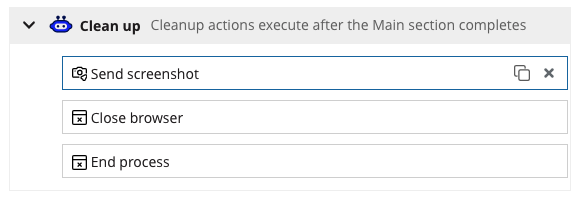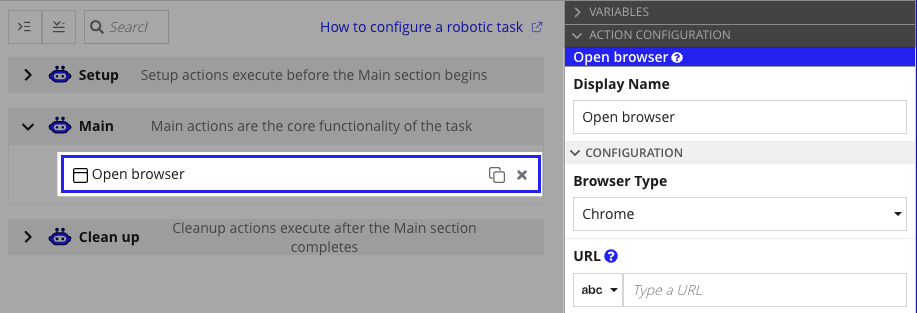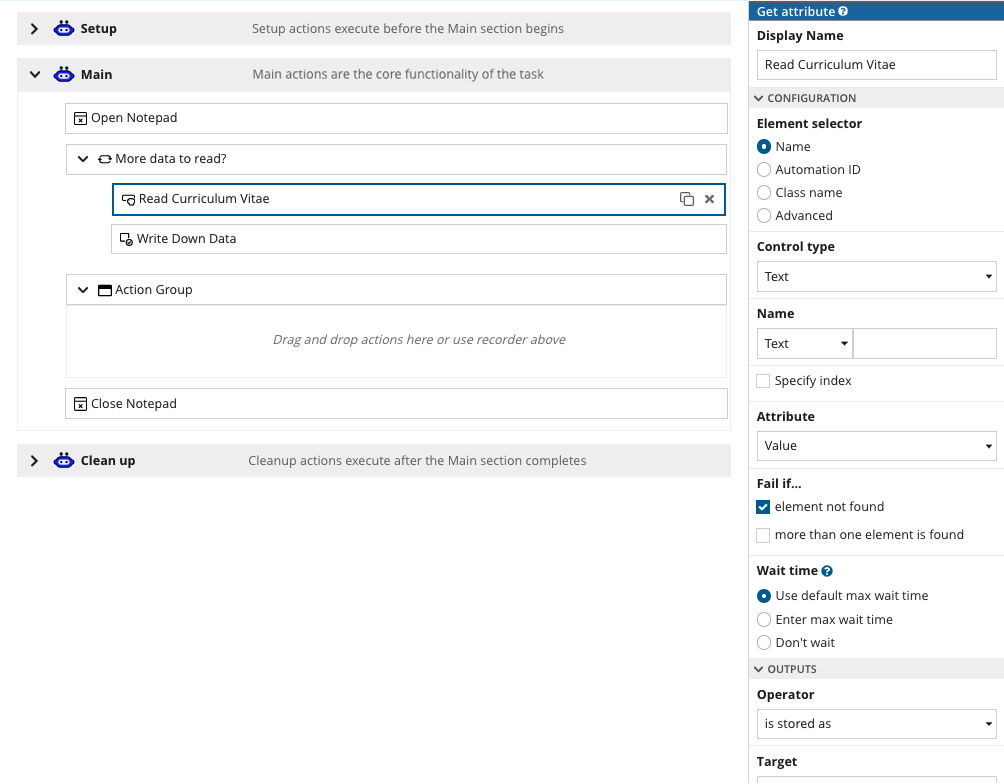| The capabilities described on this page are included in Appian's standard capability tier. Usage limits may apply. |
On the Edit tab of the robotic task configuration page, you can configure the following settings:

Robotic tasks follow a specific sequence. The definition is the guide that leads the robotic task's operation, determining its starting point and driving it through a series of tasks and actions.
Tip: Do you need more information about robotic tasks before you configure the Edit tab? The Robotic Task Definition page has the information you need.
The following image highlights the interface elements that you use to set up a robotic task definition:
Similar to the Interface Designer, the Palette shows you the actions that are available to add to the robotic task. Use the search bar to quickly find an action by name, or browse the list of actions within each low-code module.
The Action Group action is part of the General module and can help you organize actions that work together to achieve a desired outcome. For example, you may want to organize your robotic task definition so that login actions are contained in an action group. To add an action group to the robotic task definition, click and drag Action Group from the Palette to a section.
Tip: As a best practice, limit each action in your robotic task to 12 or fewer nested actions. Having more than 12 nested actions can lead to performance problems. Instead, split the robotic task into smaller robotic subtasks to prevent problems from occurring.
At the top of the robotic task definition, you'll find options to help you find what you're looking for:

By default, every robotic task definition has a Setup, Main, and a Clean up section. Click the arrow in the section's toolbar to expand or collapse that section.
Within each section, you can drag and drop actions to new positions or delete an action by hovering over the action and clicking Delete action.
Setup section: Certain tasks may need to be completed to prepare the robot for an item execution. You can define those actions in the setup section of the robotic task definition. If you use credentials in a setup section, the credentials are reserved and won't be released until the clean up section successfully completes. This may impact credential availability if the setup and clean up sections are skipped for consecutive executions. See Execution Settings to learn more about how the robotic task behaves when the setup and clean up sections are skipped for consecutive executions.
Clean up section: Whether the robotic task ended successfully or not, the end of an execution is a good moment to close the applications that the robotic task has opened or send the files generated during execution to the server. It's important to reset the robot to its previous conditions so subsequent robotic tasks can execute successfully. Without consistent starting conditions, other robotic tasks may not be able to start or complete. Remember that the steps you configure in this section only apply to the robotic task you're currently configuring. You don't need to add the clean up section to your main robotic task definition. The robotic task will always execute the clean up actions.

Tip: If the same robotic task executes multiple times consecutively, you have the option to skip the setup and clean up sections for faster executions.
When you add an action to the robotic task definition, the configuration options appear in the Action Configuration pane. The configuration options vary based on the action you're adding.
See the action documentation for details on each action's configuration options:
You can use robotic task variables to pass data between robotic task definition actions and other design objects like process models and interfaces. The robotic Variable grid should look familiar if you've worked with rule inputs in the Expression Editor or Interface Designer.
It's simple to reference your variables in a robotic task. Text fields that are found in the configuration options for robotic task actions allow you to select from a variable picker. Use the variable picker to choose a variable as a value for your robotic task. What's more, when you rename variables, Appian automatically updates their names throughout your entire robotic task.
See the Robotic Task Variables topic for more detailed information.
To create a variable in a robotic task:
Credential type is used to reserve credentials for use in robotic subtasks.
Dropdown. The default value of the variable at the start of the task.Password and Dropdown. Indicates if the variable can pass values to the robotic task before it executes. Before the robotic task executes, the user will be prompted to provide an input.The Test button launches the debugging tool to where you can go through the robotic task definition action-by-action and isolate where issues might arise. See the Troubleshoot Appian RPA topic for detailed information about the debugging process.
The robotic task definition supports the task recorder tool. The task recorder can automatically record your browser interactions and translate them into robotic task actions. You can start a recording from a section, action group, or conditional flow path.
To start a recording:
Required role: Developer or Administrator
To configure a robotic task definition:
Tip: Looking to speed up robotic task definition design? Create robotic task definition sections using the task recorder.
To add an action to the robotic task definition:
That's it! You can configure the action in the Configuration Pane.
Tip: As a best practice, limit each action in your robotic task to 12 or fewer nested actions. Having more than 12 nested actions can lead to performance problems. Instead, split the robotic task into smaller robotic subtasks to prevent problems from occurring.
Action groups help you organize actions that work together to achieve a desired outcome. For example, you may want to organize your robotic task definition so that login actions are contained in an action group.
To add an action group to the robotic task definition, click and drag Action Group from the Palette to a section.
The robotic task definition allows you to quickly configure conditional flows. Conditional flows are decision points for a robotic task's execution, where the path of the flow adjusts based on specified conditions. The results of conditional actions determine the path the robotic task will follow. Use conditional actions to make your robotic tasks more dynamic. For example, if a web element is present, copy the value; otherwise, add an error message to the log.
Conditional actions only return true or false and include:
When you place conditional actions in the robotic task definition, they automatically generate Yes or No flows to configure. Actions that return true map to Yes flows; actions that return false map to No flows. Add actions to the resulting flows just as you would for the main robotic task definition.

Loops repeat actions until a condition is satisfied. Use the Loop action to process items in a list such as files in a directory or line items on an invoice. RPA supports the following loop types:
false.Tip: Loops can't repeat more than 1000 times.
In the following example, the loop will execute the Create a folder and Copy a file or folder actions until the Loop Expression returns false.

To add and configure a Loop action:
Action expressions in loops can reference function variables (../Expressions.md). Supported function variables in loops include:
| Function Variable | Description | While | Repeat | For Each |
|---|---|---|---|---|
fv!index |
The current iteration of the loop, starting at 1. | Yes | Yes | Yes |
fv!isFirst |
true for the first iteration of a loop, otherwise false. |
No | Yes | Yes |
fv!isLast |
true for the last iteration of a loop, otherwise false. |
No | Yes | Yes |
fv!itemCount |
The total number of loop iterations. | No | Yes | Yes |
fv!item |
The current item. | No | No | Yes |
When you add an action to the robotic task definition, the configuration options appear in the Configuration Pane within the designer. The configuration options vary based on the action you're adding.

See the action documentation for details on each action's configuration options:
pv! and concatenate variables as needed.For example:

is stored as) or add the value as a multiple-value variable (is appended to).To move a single action within a robotic task definition section, drag and drop the action to a new position.
To delete an action, hover over the action and click Delete action.
Robotic task variables can store and pass values in your robotic task's definition and even between your robotic task and other design objects.
Similar to process variables in a process model, robotic task variables are placeholders for data that can be accessed throughout the lifecycle of a robotic task. These variables can be referenced in actions to display values or to store an action's result value and use it later in other actions of a workflow. You can also set robotic task variables as parameters so they can be used as input fields in a robotic task's execution.
Tip: Do you want more information about robotic task variables? The [Robotic Task Variables] page in the Learn category has more information to get you started.
Complete the following steps to create a new robotic task variable. You can also create robotic task variables as you record actions with the task recorder

Configure the following fields in the Create Variable dialog:
| Field | Description |
|---|---|
| Name | The name of the robotic task variable. Only letters, numbers, and underscores are accepted. |
| Type | The data type of the robotic task variable. Robotic task variables can be primitive data types, legacy instructions types, or custom data types (CDTs). The Credential type is used to reserve credentials for use in robotic subtasks. Note: The following system types cannot be selected for a robotic task variable type: Encrypted Text, Time, complex system data types, and hidden CDTs. See the Data Types page for a complete list of system data types. |
| Array (multiple value) | Lets the process variable accept an array of values. You cannot enter an initial value if this checkbox is selected. If your variable is a parameter and you select this checkbox, you can only pass one value when executing the robotic task from the console. To pass multiple list values in your input parameter, use the Execute Robotic Task Smart Service. |
| Initial value | The default value of a robotic task variable. Note that you cannot provide an initial value if you select the Array checkbox, if your variable is type CDT, or if your variable is type Date or Date and Time and marked as a parameter. |
| Parameter? | Allows variables to pass values to the robotic task before its execution. If selected, the variable will be used as an input field for the robotic task's execution. Input fields ask a user to provide data before a robotic task is executed. |
| Required? | Requires that a parameterized variable has a value before the robotic task is executed from the Execute robotic task page in the Appian RPA console. |
To edit a robotic task variable:
To delete a robotic task variable: